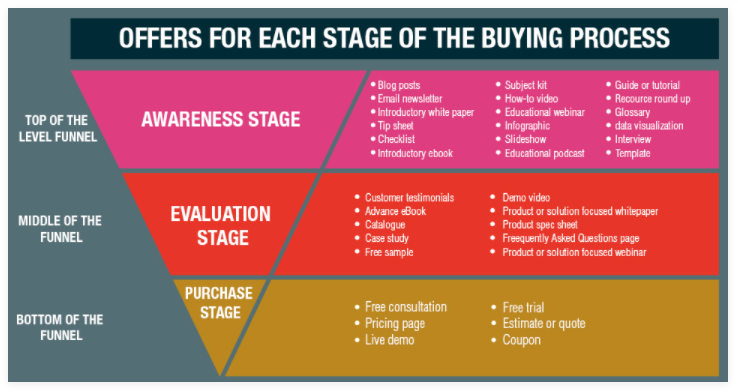Understand how the conversion funnel works Before you can create highly relevant content, it’s important for you to make sure that you’ve got a firm grasp on the conversion funnel. Once you understand the conversion funnel, and more specifically, the bottom of the funnel, it will be much easier for you to adjust your content strategy accordingly to drive sales. Create a customer journey map Journey maps are a great resource because it takes you through the buying process even further than the conversion funnel. Yes, of course, new customers are great. But ultimately, customer personas will give you more inspiration so that you can stay relevant with your content strategy. But based on the research that you’ve conducted between your conversion funnel, customer journey map, UTM parameter tracking, and customer personas, you’ll have plenty of information to use for each type of content. Research shows that generating traffic and leads are the top marketing obstacles that businesses are struggling to overcome. You’ve also got to keep track of news and trends within your specific industry. Then, create a customer journey map to help give you a better understanding of what the consumer wants. What type of highly relevant content is your company using to drive more sales?
Content marketing is an absolute necessity for brand survival in 2018.
So you’re on the right track if you are currently creating and distributing content. But for those of you who aren’t seeing results from these marketing campaigns, it can be frustrating.
You’re putting so much time and effort into this, so why aren’t you seeing results? What’s the issue?
I see this problem a lot when I’m consulting with businesses. They don’t have a clearly defined content strategy. If this sounds like you, it’s important that you read carefully.
It’s great that you are continuing to publish new content. But this isn’t effective if your sales aren’t increasing.
Sure, content marketing can be used for lots of different things. Primarily, businesses use content marketing to:
- generate leads
- acquire new customers
- increase brand awareness
- establish credibility
- engage with an audience
All of these are great and critical for success. However, you need to learn how to create content that directly drives sales.
That’s why you got into business in the first place, right? You wanted to make money. I can sum up one of the best ways to create content that drives sales in just one word.
Relevancy.
If your content isn’t relevant, you won’t see high conversions. It’s that simple. So follow this guide on how to drive sales with highly relevant content. Here’s what you need to know.
Understand how the conversion funnel works
Before you can create highly relevant content, it’s important for you to make sure that you’ve got a firm grasp on the conversion funnel.
You’ll see different variations of this funnel depending on which marketing website or expert you are referring to. It can also look slightly different depending on the industry and business model.
But for the most part, the conversion funnel can be broken down into three stages.

The top of the funnel occurs when a prospective customer becomes aware of your company. They’re conducting research or looking for an opinion. Basically, they need an answer to something and they are seeking insight.
Once a consumer knows that your brand exists, they enter the middle stage of the conversion funnel. This is the evaluation phase.
They are still conducting research, but now they are taking it one step further. Consumers are trying to decide if your product or service fits well for them and their specific needs.
Finally, the consumer reaches the bottom of the funnel when they enter the purchasing or conversion stage.
This is the area of the conversion funnel that you need to focus on the most when it comes to creating highly relevant content.
The bottom of the funnel is your chance to explain to your customers why your product and service is the best for them. Show your differentiation from the competition.
Educate the consumer. Explain what it will be like for them if they become a customer.
Marketing campaigns that entice them can include demonstrations, free consultations, free trials, estimates, quotes, coupons, and pricing. Basically, it’s anything to give them an incentive to buy.
Once you understand the conversion funnel, and more specifically, the bottom of the funnel, it will be much easier for you to adjust your content strategy accordingly to drive sales.
It doesn’t matter whether you are a B2C or B2B company, you’ll still need to evaluate your funnel.

But ultimately, the funnel can still be broken down into three stages.
Create a customer journey map
Journey maps are a great resource because it takes you through the buying process even further than the conversion funnel.
Your journey map will focus on elements that take place after the purchase, instead of just before. So while awareness and consideration will still be part of your journey map, you’ll also focus on your customer retention strategy.
Analyze how the customer behaves after their initial purchase. This is very important when it comes to driving sales.
That’s because you’re not always going to focus all of your efforts on how to acquire new customers.
In fact, you shouldn’t be. Yes, of course, new customers are great. But it’s actually less expensive and more effective to target your current customers. So a journey map can help you accomplish this.
You’ll put yourself in the minds of your customers. Once you’re able to do this effectively, you can adjust your content strategy accordingly based on their point of view.
Track leads and conversions
Where are your leads coming from?
If you don’t know the answer to this question, it’s a big problem. This is one of the reasons why your content isn’t relevant and driving sales.
Knowing how customers discovered you can help you understand why they made a purchase. Based on this information,…

COMMENTS